I can tell that the summer is coming to a close because all I want to do is drink buckets of tea. I always love tea, but I slow my consumption down in the sweltering summer months. As soon as it dips below 75, however, my body decides that it is now autumn. Needless to say, I’m excited for more clement weather and my favorite holiday right around the corner. (Not that anyone is going to be trick-or-treating this year, but I’m determined to stay positive about Halloween anyway.)
My working life looks a bit different these days. I’m taking on less so that I can take care of my daughter during the day, but my focus is also shifting to things that I really want to be doing. I’ve been having a lot of fun with podcasting lately; it’s something I obviously have enjoyed ever since I became a permanent host of Manga Machinations, but now it serves as a tie to my pre-mom identity. And it’s a great bit of social time I’m able to look forward to every week. We wrapped up our Kasane retrospective this month, and phew! What a series! I enjoyed it way more than I anticipated, and I really loved talking about it with the guys.
Generally, with these monthly favorites, I choose to profile series that I haven’t talked about before. So if I’m continuing to read a series, I don’t always bring that up, even if I really love it. I just wanted to take a moment to acknowledge that I’m still enjoying BEASTARS. I’m a couple volumes ahead of release because I get review copies, so I just gotta say…if you’re keeping up with it so far, or if you’re on the fence as to whether or not to continue…it remains really solidly written, beautifully illustrated, and completely wild. Going forward, I’m going to try to mention series I’ve continued to read, since that usually means I’m really into it. (I have a tendency to forget about series if I’m only lukewarm on them, even if they had a strong start.)
I had a chance to read a few manga this month that I had been eagerly anticipating, so I’m excited to finally be able to share those with y’all!
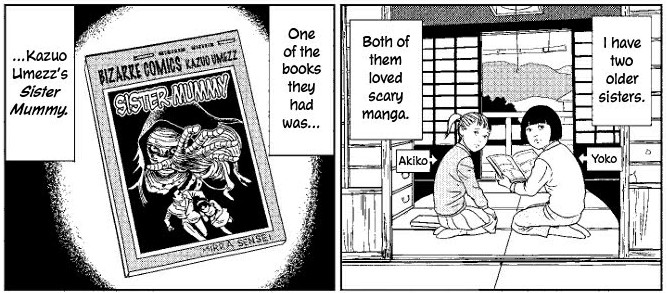
Venus in the Blind Spot — by Junji Ito, published by VIZ Media
It’s always a good month when there’s a new Junji Ito book on the horizon. I usually try not to read review copies of his stuff, because I want the experience of buying and reading the book. But this time, I just felt really compelled to write a review for Comics Beat. I really loved it; I think it might be the strongest of his anthology collections available in English so far. I was especially excited to see his adaptation of Edogawa Rampo’s creepy short story, “The Human Chair.” Ito did not disappoint — I had the same visceral reaction to this manga version as I did the original prose. My favorite offering in this collection has got to be “Master Umezz and Me,” an autobiographical piece where Ito talks about his relationship with Kazuo Umezz’s work. I have this (perhaps futile) hope that this story will inspire English-language readers to become more interested in Umezz’s work so that we can have a reprint of Cat-Eyed Boy….
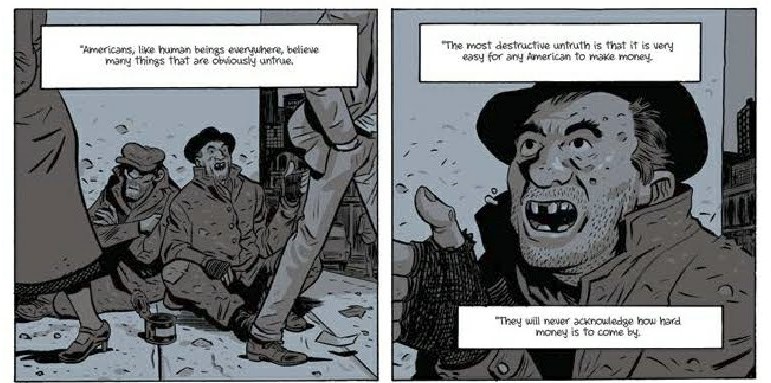
Slaughterhouse-Five, or the Children’s Crusade — written by Kurt Vonnegut, adapted by Ryan North, illustrated by Albert Monteys; published by Archaia, available September 15, 2020
I was in an airport on my way to Japan when I learned about Kurt Vonnegut’s death. It was a huge blow to me, though I had only read a couple of his books at that point. Vonnegut was a huge influence on me as a teenager, and many of his ideas remain an integral part of my personal philosophy. I was thrilled when I found out Ryan North, the writer behind Dinosaur Comics and The Unbeatable Squirrel Girl, was responsible for writing an adaptation of Slaughterhouse-Five. While I think that this comic is best appreciated if you’re already familiar with the original novel, I thought it was incredibly well done. I especially appreciate the in-story acknowledgement that it is an adaptation, talking about Vonnegut in the third person and pointing him out in crowd scenes to give the reader added perspective on his role during World War II. I’m not worried that Vonnegut will ever become an unknown name, but I like to think that this graphic novel version of one of his most beloved novels will help keep his legacy current.
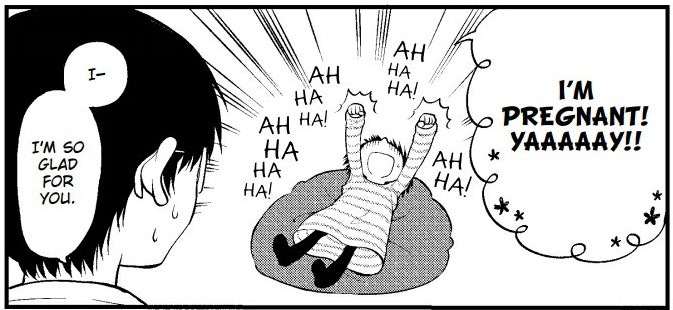
I Don’t Know How to Give Birth — by Ayami Kazama, published by Yen Press
I have been waiting for this manga forever. It was originally intended for release around my own due date, but delayed twice over. Needless to say, I was thrilled when I finally got my hands on it. I’ve mentioned before that I intend on writing a full reflection on pregnancy through comics, and the real reason I haven’t already is because I was waiting to read this, the only manga translated into English that deals directly with pregnancy. In it, Ayami Kazama talks at length about her struggles with infertility, the excitement of finally becoming pregnant, the struggle to find maternity underwear, and the uncertainty of becoming a parent. Though her experience was very different from my own, I always appreciate hearing other moms talk about pregnancy and birth. It really reinforces for me that there’s no single correct way to have a baby or to be a mom, and I find that really reassuring as a new parent, myself. Kazama’s husband, Azure Konno (also a mangaka), has little pages at the end of each chapter where he mentions his own experiences of his wife’s pregnancy. I thought this was a really nice touch, since it takes (at least) two people to make a baby! I Don’t Know How to Give Birth also reminded me a lot of chii’s The Bride Was A Boy, in that it was an autobiographical manga that used factual information to gently educate its readership on the topic at hand. I think this is a great read for anyone, but it will be of special interest to new parents, or those planning on having children.
A pretty solid lineup for August, if I do say so myself! September is gearing up to be busy (and I always get busier in the fall, but let’s see what happens since COVID prevents me from going anywhere). Hopefully I’ll have a nice little roundup for you next month, as well. Until then, stay well!
horror
April Favorites
Time moves differently when you have a baby. Though being stuck at home without seeing family and friends makes things feel sluggish, I also can’t believe that my daughter is approaching three months old in a mere few days. Maybe it’s the fact that I turned 30 at the beginning of the month, but I’m starting to feel like an old person who can’t stop saying “Where has the time gone?” Not that 30 is remotely old; in fact, I’ve been excited to reach this milestone for quite some time…though doing so while isolated has been an odd experience.
Still, some exciting things have happened this month. I’m back to recording with Manga Machinations! It’s so nice to be back talking about manga with the guys, getting a little time away from mom duties. I’m super excited that we’re doing a Yu Yu Hakusho retrospective series right now! I haven’t had an opportunity to write all my feelings about Yu Yu Hakusho (because they are vast and hard to articulate), but it’s one of my favorite series. To pique your interest, there’s an awesome promo video, as well as my reread thread on Twitter. And of course, there’s the first episode! Check it out!
Happily, I’ve been able to do quite a bit of reading this month. I’m starting to get into a good routine where that’s concerned, trying to read when Severina nurses (if she’s cooperative, which is less often lately), and then getting more reading done at night after she’s down for bed. Writing gets done during nap times — like right now, she’s sleeping on me in a sling. By the time I finish this blog post, I probably will have come back to it several times. There’s a learning curve to balancing working and parenting (and luckily I have my husband home right now to keep helping), but we’re getting the hang of it. In many ways, being at stuck at home right now is working to my benefit, even if it doesn’t always feel like it. At least there’s plenty to read!
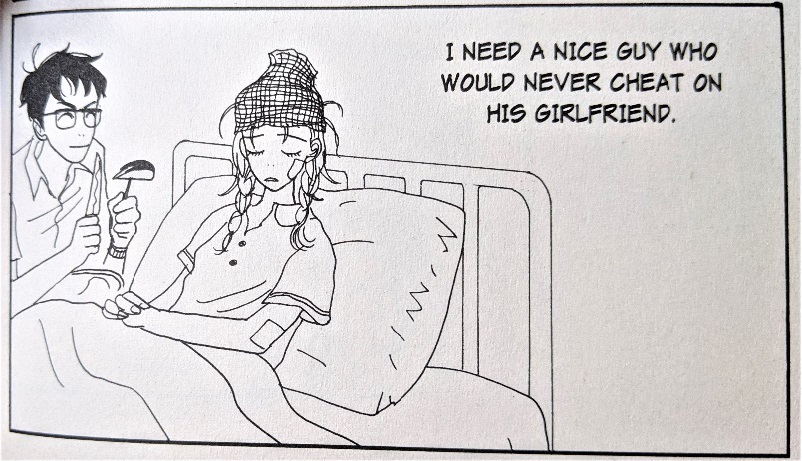
Happy Mania, Volume 1 — by Moyoco Anno, published by Tokyopop (out of print)
I’ve been feeling really nostalgic about manga lately. I’m wondering if this is a byproduct of no longer working in comics, and therefore not being up on everything that’s new right now at all times like I used to be. Regardless, this led me to find some used copies of old Tokyopop volume ones that I never got to read back when they were in print. As someone who came late to Moyoco Anno, it was important to me to check out Happy Mania. And as I expected, it was a riot. Protagonist Shigeta works at a bookstore and is desperate for a boyfriend. She continually keeps going out with guys who take her for granted, meanwhile her coworker Takahashi is clearly in love with her — and is a decent, dependable guy to boot. Shigeta is very much her own worst enemy when it comes to romance, and I continue to admire Anno’s willingness to depict women with glaring flaws. Her protagonists toe that line between insufferable and lovable, and as always, her frenetic artwork is a refreshing break from overly-trendy styles. It looks like there’s a sequel to this series in Japan. With the original out of print here, I doubt this new series will see the light of translation, but I can hope!

Spy X Family, Volume 1 — by Tatsuya Endo, published by VIZ Media (available digitally through Shonen Jump, print version out June 2nd)
People have been talking up Spy X Family for a while, and I finally got on the train because it’s coming out in print, and I have an opportunity to review it for Comics Beat (which I plan on doing). This is another one of those circumstances where I kick myself for not reading it sooner; it’s way more up my alley than I had anticipated! A spy known as “Twilight” is put on a mission to infiltrate the prestigious school, necessitating the acquisition of a fake family. The catch is that his “family” cannot know about his mission, otherwise it will be jeopardized. He adopts a little girl named Anya, not realizing that she is the result of government experimentation that left her with psychic abilities. Through happenstance, he marries an assassin named Yor, who is also trying to keep her job a secret from him. Little Anya is the only one who knows the whole story, and she isn’t telling anyone! I’m sure I’ve mentioned before that I’m a sucker for found family stuff, and I especially love Twilight’s reasoning to become a spy in the first place. The first volume is equal parts hilarious and heartwarming, and I am definitely planning to continue reading.
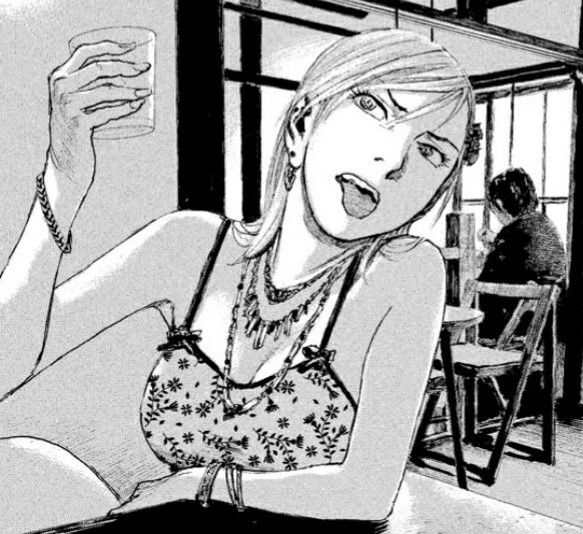
Wave, Listen to Me!, Volume 1 — by Hiroaki Samura, published by Kodansha Comics (digital available now, print version out May 26th)
Time to confess that I’ve never read Blade of the Immortal (and I suspect it’s not really my kind of manga). This is actually the first Hiroaki Samura manga I’ve read all the way through, and I was surprised by how much I liked it. Minare Koda is a loud-mouthed waitress who spills her drunken heartbreak to a local radio show host at a bar one night. He records her ramblings and airs them on live radio, pulling her into the world of broadcasting with his desire to harness her untrained but ceaseless voice and see what comes of it. Minare reminds me a bit of Shigeta from Happy Mania, actually, in that she’s a fast-talking lady preoccupied with her love life who goes off on wild fantasy tangents a lot. Samura is an excellent artist, so I’m really glad to be able to read something of his that doesn’t seem to rely on the, uh…torture of women. Though Minare might feel tortured to some extent in this series! There’s a current anime adaptation of this series airing right now, as well, which makes the print version’s timing excellent.
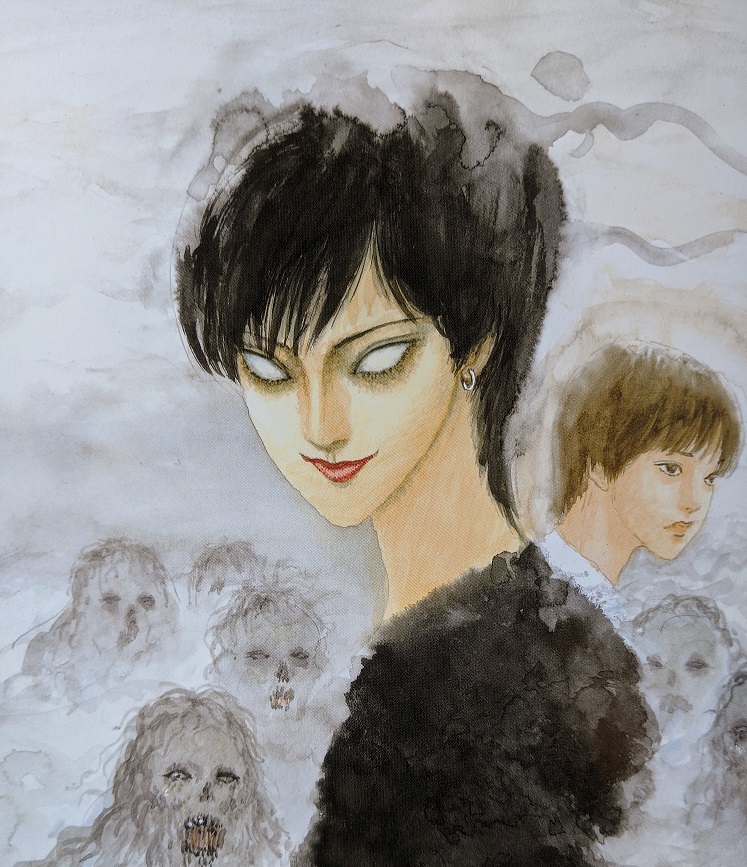
The Art of Junji Ito: Twisted Visions — by Junji Ito, published by VIZ Media
When VIZ announced that they were going to be publishing this for North America, I was really glad I hadn’t dropped $90CAD on the original Japanese printing at TCAF last year — though it was extremely tempting. To say that it’s a gorgeous collection of paintings and illustrations is an understatement. The silver and black of the jacket is echoed on the interior pages that were originally black and white, giving the feeling that they are truly special. Most fans are used to seeing Ito’s pen and ink illustrations, and while there are plenty of those, it is exciting to see his painting work, and to learn in the interview at the back that his original intention was to be a painter and not a mangaka at all. As always, his quirky and self-deprecating sense of humor shines through in translation. This is a must-have for an Ito completionist (like myself), and a great addition to any art book library, as well.
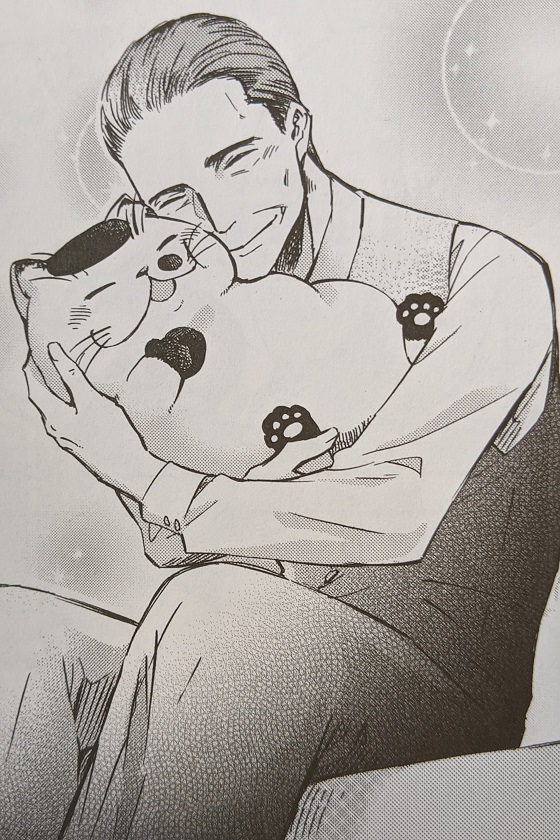
A Man and His Cat, Volume 1 — by Umi Sakurai, published by Square Enix
Square Enix is having a moment right now with the release of the new Final Fantasy VII remake. But a couple months back, they released their first manga as a North American publisher (having already been a publisher in Japan for many years). One of those new manga is A Man and His Cat, AKA the exact kind of thing I love to read. In it, a chubby, so-ugly-he’s-cute cat who has been ignored by shoppers at a pet store for over a year is worried that he will never find his forever home. One day, however, an older gentleman adopts him, naming him Fukumaru. The man had been living all alone after the death of his wife, and the two had always talked about getting a pet. The first volume is packed with situations instantly recognizable to those who share their home with a cat. In many ways, it reminded me of What Michael?, except there is a loose ongoing plot and far less absurdist humor. It’s sweet, it made me chuckle, and I’m looking forward to more!
If we stay in a state of relative physical isolation for much longer, all of my monthly favorites are going to be this long! Hopefully there’s something here to help you pass the time, as well. Stay safe!
December Favorites
It wasn’t that long ago that I wrote up my favorite comics from November, but here we are already — the last day of 2019. It’s been quite the year for me, both in terms of my involvement with comics and in my personal life. A new year and a new decade is an exciting prospect! This will probably be my last monthly favorites post for a while, since next month I’ll be getting my bearings as a mother. As promised, I’ve been trying to slowly collect comics on pregnancy and motherhood, so I hope to write about that once I have some of my own experience with this new part of my identity! And I’m thinking of trying to combine some of my parenting experience with comic recommendations, but that might have to wait until my little one is out of infancy — we shall see!
But anyway, I’m jumping the gun a bit here. For this month, I’ve got a couple goodies that deserve some recognition!

Hell’s Paradise: Jigokuraku, Volume 1, by Yuji Kaku — published by VIZ Media
So far, I’ve only read the first volume of this series, despite the fact that it can be read chapter-by-chapter on the Shonen Jump website. A print copy is coming out in March, so I snagged an advance review copy — and I’m glad I noticed it, because otherwise I may not have thought to read this series! Ninja assassin Gabimaru has been sentenced to death for his crimes, but the stoic executioner Sagiri has been able to discern that he wants nothing more than to be reunited with his wife. She makes a deal with him: Gabimaru can go free if he finds the elusive Elixir of Life on behalf of the shogun. The Elixir is rumored to be on a mysterious island that keeps sending back every explorer as hardly human, blissful and with flowers growing out of their bodies. I enjoyed this first volume because it combines my interest in aesthetic violence/gore, my appreciation of a supposedly unfeeling character with an emotional weakness, and a complex female character who has to overcome her own insecurities as the story progresses. There are some seriously creepy monster designs even just in this initial book, so I’m looking forward to what this strange hell island has to offer going forward!

The Harrowing of Hell, by Evan Dahm — published by Iron Circus Comics, out March 10, 2020
It’s been a…hellish month, I guess! I don’t talk much about religion in general, but I was raised Catholic and even though I am not practicing, there are a lot of aspects of my religious upbringing that are still important to me. Chief among them is Jesus as a man, trying despite all the setbacks to preach radical peace. I follow creator Evan Dahm on Twitter, and I’ve been looking forward to his interpretation of Jesus’s descent into Hell for a long time now. The final product — or at least the advance copy I was able to get — is a gorgeous, black-white-and-red, ink-heavy, heart-heavy journey that was a pleasure to read. It spoke to me very directly as a lapsed Catholic, and as someone who appreciates seeing the humanity in Jesus more than the divinity. I think I’d like to read it again once it officially comes out to see what I’ve missed, because I suspect that the physical book will offer a more satisfying, tactile read than the digital galley. This is the second of Dahm’s works I’ve read, and I continue to be impressed by his ability to say so much with imagery. Also, I just really liked the little ribbon-like tails on the word bubbles in this volume. It was a sweet little detail that felt very special and carefully considered.
I suppose it seems odd to end the year/decade reading books about Hell or Hell-like places! It wasn’t really intentional, but these types of stories tend to be among my favorites. I’m hoping to read a lot of Jigokuraku while on my self-imposed maternity leave; in fact, I’m hoping to get a lot of reading done, in general, since I’ll have a lot of time where I’m sitting still holding/nursing a baby. Best laid plans of mice and Mo, of course — I feel as though I say I hope to read more every month.
There may be one more blog post in me after the New Year and before the baby arrives. But just in case there’s not, I hope everyone has a wonderful start to 2020, and that the year ahead brings lots and lots of manga to everyone!
Hallowmangaween!
Halloween is my favorite holiday. As far as I’m concerned, it’s a month(s)-long revel in the joys and fears of mortality, capped by the actual three-day event (Halloween, All Souls’ Day, and All Saints’ Day — I was raised Catholic!). And every year, I tell myself I’m going to experience it to its fullest and be the absolute Halloweeniest I can be — which is almost always derailed by being involved in one too many other activities.
One of my intentions every year is to write about Halloween-appropriate manga, meaning outright horror fare, as well as titles that just generally get into the Halloween spirit. When someone asked me recently on Twitter if I was going to do a horror post for October, I realized that I really had to stop procrastinating and give it a go. And so here we are.
There are countless manga that work in a round-up like this, and countless in-depth pieces that can be written about each of them, surely. For the purposes of this year’s attempt, I’m going to pick out some of my absolute favorites and separate them into different categories in an effort to make this all easy to digest. I hope that this list provides you all with some spooky reading to accompany your horror movie marathons, costume balls, haunted hay rides, cider-sipping, candy-scarfing, and general creepy merriment!
Monster Children
As a society, we’ve decided that children are scary. They pop up in horror films both in Japan and in the West, eerie because of their unpredictable nature and the lack of reason and logic that governs an adult mind. The monster children of the manga I’ve chosen are a little different, operating more as either moral guides or as helpless, sympathetic figures who have unfortunately lost their way or been made to perform bad deeds. I’m particularly fond of this kind of narrative, which asks the reader to consider what exactly it means to be a monster. Very Frankenstein, but with the added bonus of using children for maximum emotional manipulation!
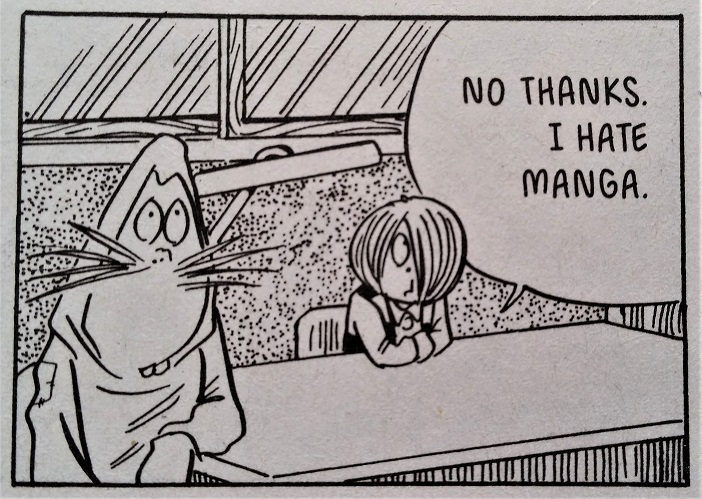
Kitaro, by Shigeru Mizuki — published by Drawn & Quarterly
Shigeru Mizuki’s classic tales about little Kitaro, last of the Ghost Tribe, are truthfully not very scary. But they are wickedly fun, reveling in a world populated by yokai and monsters of many cultural origins. Kitaro, with help from his father, the walking eyeball Medama Oyaji, and a motley cast of yokai, seeks to rid humankind of cruel, greedy, or evil yokai. He is a superhero of sorts, one who lives between the world of the living and the world of the fantastical. Originally intended for younger readers, the Kitaro stories are rife with silly gags and cartoonish characters, laid over the lush background settings meticulously penned by a one-armed Mizuki. In fact, the legendary mangaka is credited for single-handedly bringing yokai back into the modern consciousness after the Second World War, and I highly recommend seeking out his other yokai-related works. I have a copy of his yokai artbook — a beautiful gift from my husband — which nearly made me cry with its beauty. As a creator, Mizuki embodies several of my favorite things: a love of the strange, an eye for the beautiful, and a willingness to have fun — and to tell poop jokes.
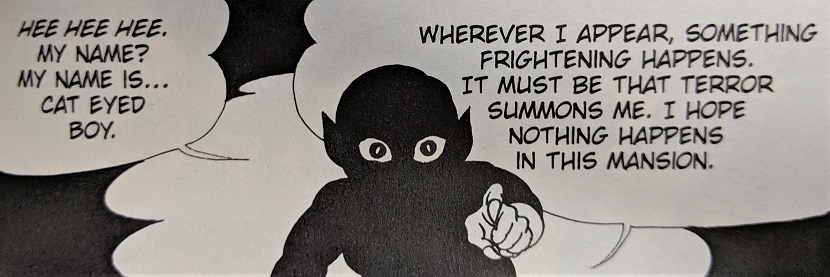
Cat-Eyed Boy, by Kazuo Umezu — published by VIZ Media (out of print)
With the gorgeous hardcover reprint of The Drifting Classroom so fresh in everyone’s minds, I want to draw attention to my favorite of Kazuo Umezu’s works. Cat-Eyed Boy is a very me manga, starring yet another cheeky monster-child who gets tangled up in the lives of humans. Like Kitaro, Cat-Eyed Boy finds himself rescuing people more often than not, but rarely is he appreciated for his efforts. He’s not well-liked by humankind, doesn’t really fit in with other monsters, and has an all-around salty attitude toward everyone. And he’s precious. Umezu, known for both his horror and his gag manga, combines the two disciplines well in this series. His monsters are more threatening than Mizuki’s, the stakes are often higher, and there are fewer neatly-tied story bows. It puts one in mind of early, pulpy horror comics from the West, stuff like Haunt of Fear or Eerie Comics. Really delightfully naughty scary fare for the mischievous little wanker in all of us.
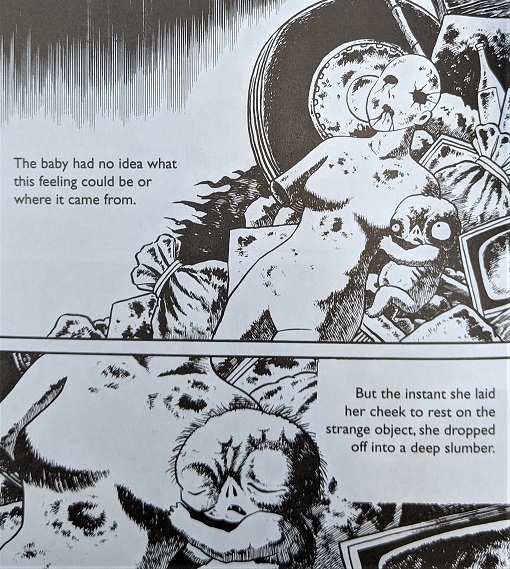
Hell Baby, by Hideshi Hino — published by Blast Books (out of print)
It kills me that there are no Hideshi Hino manga currently in print. I want to recommend him to everyone who loves Junji Ito, a mangaka who has spoken of his great love for both Hino and Umezu countless times. In Hell Baby, twin girls are birthed to an excited couple, but they soon discover that one of them is hideously disfigured. Because the new dad is apparently going to win zero parenting awards, he dumps the offending child in the literal garbage, where she predictably dies. But that is not the end for this strange infant. Spirits merge above the junkyard where her corpse rots, entering it and imbuing it with new life. From there, she grows by eating carrion, drinking ditch water, and slurping up earthworms. She is a monster who grows to wreak havoc on the community, destined to get her revenge on the family and the society who spurned her. But she is deeply sympathetic as well. There are scenes of her snuggling up next to a decaying mannequin in the junkyard that make my heart ache for her. Talk about Frankenstein vibes! Hino’s artwork is gross and wonderful, full of inky blackness and never shying away from the horrors perpetrated against Hell Baby — and by her.
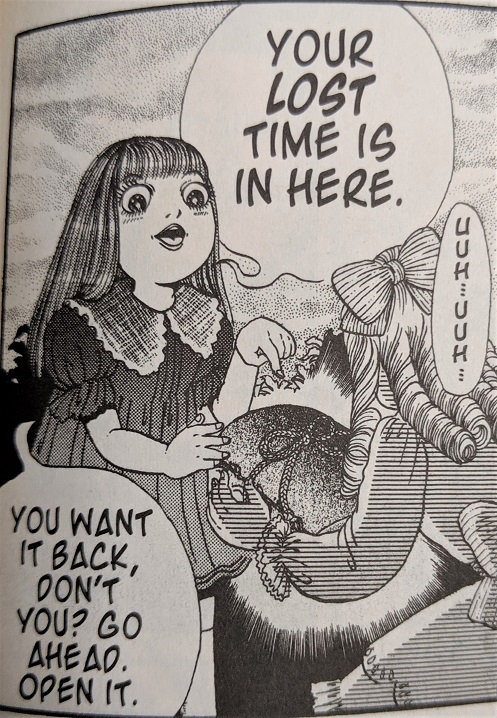
Presents, by Kanako Inuki — published by CMX (out of print)
Another thing we don’t have enough of in North American manga publishing is horror series by women. A couple of Kanako Inuki’s works have come over but are long out of print. Presents could actually fall under “morality plays” too, but because the protagonist, Kurumi, is a child of sorts, it felt right to include it here. Kurumi was never given birthday presents as a child, and because of this has somehow ceased aging. It is her dark duty to wander the world giving presents to others — but these gifts are often more frightening than fun, providing the receiver with their just deserts. Inuki’s artwork is wonderfully bizarre, her characters — nearly all children — squat and bug-eyed, with over-exaggerated expressions. She utilizes a great deal of detail in backgrounds and clothing, placing her doll-like figures in realistic 90s-modern settings. Delightfully fun and creepy, and satisfying in the way it punishes only the deserving while keeping the cursed protagonist as the sympathetic character.
Ghost Stories & Possessions
It can’t be a Halloween recommendation list without ghosts! I took some liberties with what “possession” meant in this category, but basically if it involves haunting or hobknobbing with supernatural entities, and I couldn’t fit it somewhere else, I put it here!
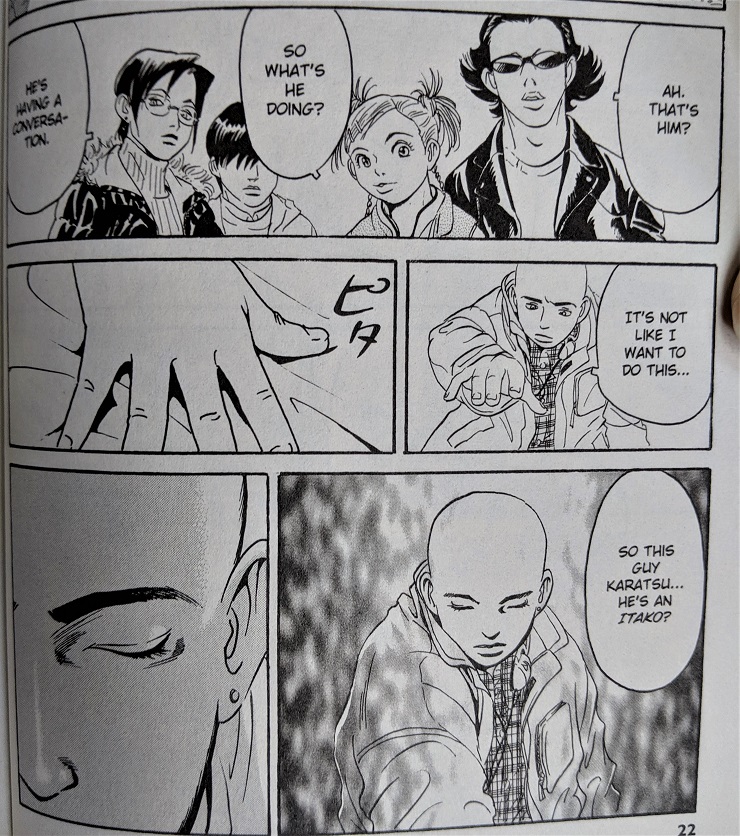
The Kurosagi Corpse Delivery Service, by Eiji Otsuka & Housui Yamazaki — published by Dark Horse Comics
I have the omnibus versions of this manga, and every time I bought a new one I told myself I would only read one single volumes’ worth and save the rest for the next night. And every time I cracked one open, I devoured the entire thing in one sitting! Our protagonists are five students at a Buddhist university, each with their own special skills or abilities, including embalming, hacking, dowsing for spirits, communicating with alien lifeforms, and being able to channel the dead. Through the use of these skills, the group has created a service through which they perform the final wishes of the deceased. It’s an unusual way to make ends meet, but it seems to work for them! I love the mix of laid-back irreverence displayed by students who are supposed to be at a religious school, paired with their dedication to ultimately doing the right thing to help the dead rest in peace. This series is definitely not for the faint of heart, as there are some really disturbing deaths, but Housui Yamazaki’s clean, controlled artwork is a pleasure to look at, no matter the subject. I desperately want more people to pick this series up so that Dark Horse knows exactly what a gem of a manga it is and continue publishing it — so please, give it a try!

The Black Museum: The Ghost and the Lady, by Kazuhiro Fujita — published by Kodansha Comics
I initially bought this series because I was intrigued by the subject (ghosts) and the artwork (which has the air of a vintage series, despite having originally come out in 2007). What I wasn’t anticipating was that it was also an historical fiction series set during the Crimean War and largely starring that most famous of nurses, Florence Nightingale. The story is told in a flashback narrated by the Man in Grey, a ghost haunting the Black Museum who had struck up a sort of deal with Nightingale, who herself was surrounded by malevolent spirits at all times, that he can kill her once she finally succumbs to despair. The series is two volumes long (Kodansha has yet to publish the other volume in the Black Museum series, about Spring-Heeled Jack), and full of rich, energetic illustrations of ghosts, mass (gross) illness, feminine grit, and plenty of dueling!
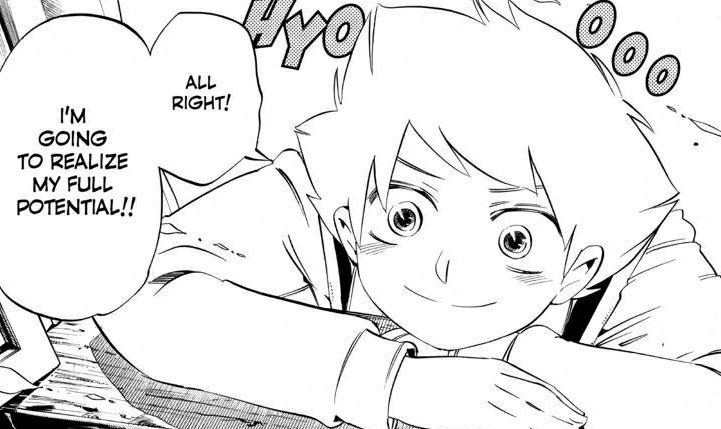
Muhyo & Roji’s Bureau of Supernatural Investigation, by Yoshiyuki Nishi — published by VIZ Media and available in full on their Shonen Jump app
There are a few Shonen Jump series that could potentially squeak by in a Halloween round up (my two favorites, Yu Yu Hakusho and Yu-Gi-Oh! might count as “spooky” on a technicality), but Muhyo & Roji is one of those series that doesn’t get nearly enough attention, and it’s strictly about ghosts, exorcisms, and general spookiness! When I started reading this series through the then-new Shonen Jump app, I thought it was going to be an episodic monster of the week type deal (which I love), but it actually ended up having a very full story line — and an ending! A shonen series with an ending! Muhyo is a young exorcist of immense ability, and Roji is his apprentice. The two are tasked with exorcising malevolent spirits, but eventually they get dragged into a more earth-shattering issue when a former classmate of Muhyo’s becomes possessed by an evil entity. I simply adore Yoshiyuki Nishi’s inventive and weird creature designs, as well as the relationship between the two main protagonists. (Muhyo shows his affection mainly through being ornery, which is a weakness of mine!)
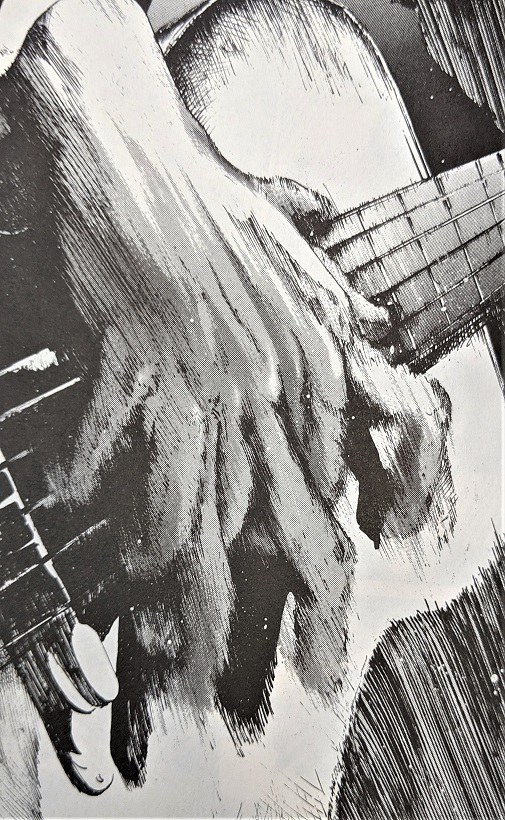
Me and the Devil Blues, by Akira Hiramoto — published by Del Rey (out of print)
I had a hard time deciding which category to fit this manga under, but I wanted to make sure I mentioned it. Another historical fiction series, this one was penned by Akira Hiramoto, best known currently for Prison School — but the two series couldn’t be any more different. The manga is named after the song by blues legend Robert Johnson, who is mythologized as a man who sold his soul to the Devil in order to play guitar in the unique way that he did. Hiramoto has decided to play with that myth, depicting Johnson as a man possessed with infernal ability. The result is a gorgeous, dark, angry depiction of the American South that is surprisingly adept with its awareness of race relations and the struggles of a young black musician in the 1920s and 30s, considering it was made by a Japanese man in the 00s. I definitely want to give a warning for violence and offensive language, as the subject matter comes with a lot of baggage related to Jim Crow laws. Hiramoto utilizes an incredible breadth of artistic abilities in this manga, with chapter headers often done in charcoal or graphite, and certain sequences portrayed in brush work instead of pen and screentone. It’s a real gem of a manga, and it’s a shame that it’s out of print and hard to find. If you love gritty Southern Gothic tales, this is a good pick for sure!
Morality Plays with Beautiful Art, Beautiful Men, and Plenty of Mind-Breaking Horrors
You all must know by now that this is one of my absolute favorite genres of fiction, between my writing about it here in the past and tweeting about it all the time. But I’m such a sucker for a mysterious entity doling out prizes or punishments to the deserving (or undeserving) masses. I’m that lady who has The Twilight Zone theme song as my ringtone, so there should be no surprise about my tastes, haha. In recent years, I’ve been able to find a few more examples making their way into English, so I want to share them!
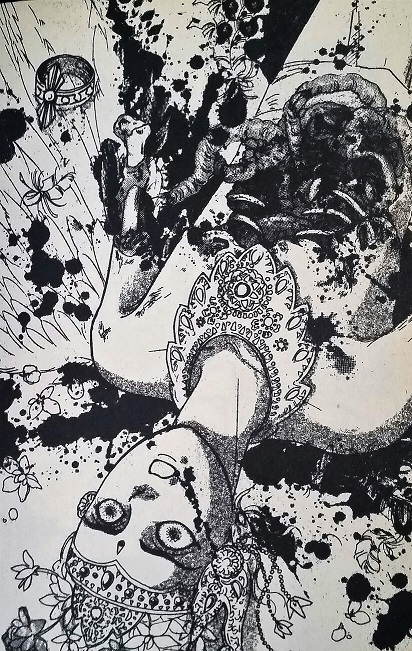
Pet Shop of Horrors, by Matsuri Akino — published by Tokyopop (out of print)
Okay, I wrote a whole long love-letter to Pet Shop of Horrors earlier this year, and everything I said there still stands. This was the manga that started it all for me, with gorgeous art offset by horrifically detailed punishments. For those unfamiliar, Count D is the proprietor of a pet shop in Los Angeles’s Chinatown, where he provides rare and exotic animals to those seeking something beyond a mere cat or dog. Detective Leon Orcot of the LAPD is determined to bust the Count for operating a drug ring or being involved in some other kind of illegal behavior, but instead he is drawn into the mysterious world of animals who are more than what they seem. The series is unfortunately out of print, and its sequel, Pet Shop of Horrors: Tokyo, was never completed in English. You can watch the anime over on Hi-Dive, and while I don’t think it’s quite as entrancing as the manga, it will give you a good idea of the characters and the premise.

Nightmare Inspector, by Shin Mashiba — published by VIZ Media
Soon after starting work at Comicopia, I discovered the existence of Nightmare Inspector and promptly ordered myself the first volume. I was thrilled to finally have something similar to Pet Shop of Horrors in premise; it had been so long since I had read it and I wanted to fill that niche again. Here, our mysterious entity is a baku named Hiruko, who eats the nightmares of the clients of the Silver Star Tea House in an effort to help them work through issues. Hiruko has his own dark past, of course, so there is an ongoing plot that inches forward with each new client’s problems. Shin Mashiba’s artwork is way more cutesy and mid-2000s than Akino’s sublime 90s high shojo work, but that cuteness belies many violent images and intense stories of trauma and fear. Lots of fun, worth picking up if Pet Shop is your thing!
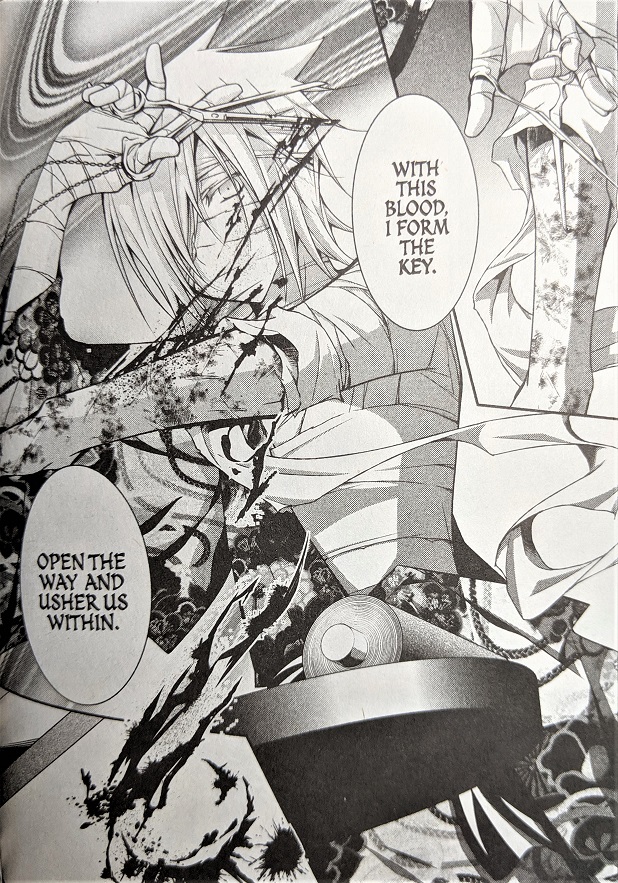
Yokai Rental Shop, by Shin Mashiba — published by Seven Seas Entertainment
Another work by Mashiba! This series came out more recently, in four regular-sized volumes that make it a nice quick Hallowread. In this series, regular old civil servant Hiiragi learns that his half-brother is the proprietor of a pet shop. Said brother, Karasu, is in fact the proprietor of a yokai pet shop, where he forms contracts with various yokai to help his clients meet their needs — often with a hefty price. Karasu and Hiiragi are soon embroiled in their own family fiasco, however, dealing with their cruel yokai father and his desire to create the perfect yokai-human hybrid. Mashiba’s artwork has certainly matured since she wrote Nightmare Inspector, combining digital techniques with traditional. And her monster designs remain creepy and fun, as well!
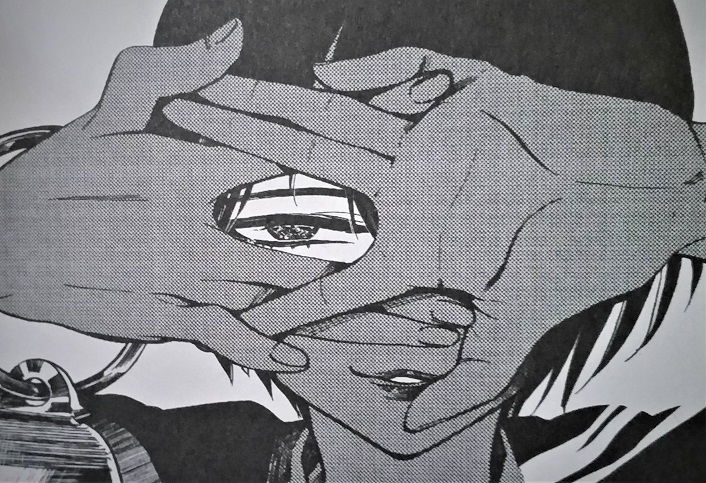
Phantom Tales of the Night, by Matsuri — published by Yen Press
I wrote about this series as one of my favorite reads for September, and I think of the newer morality-play-type works I’ve read, it’s probably the most different. In Pet Shop, Nightmare Inspector, and Yokai Rental Shop, the various mysterious shop owners or supernatural entities are a little chaotic, but generally not outright bad. The proprietor of the inn in Phantom Tales of the Night is definitely more sinister, giving his trading in clients’ secrets a bit of a fearsome edge to it. There’s only the one volume out from Yen Press right now, so I’m looking forward to seeing where this lushly illustrated spooky train of vice takes me in the volumes to come!
Vampires
I love vampires. I can’t deny it. I love gross, hairy-palmed Draculas and beautiful, dramatic, excessively romantic vampires. I don’t really know why, but maybe it’s my love of the theatrical. Either way, I often have kind of a hard time finding vampire fiction I like, even though there’s plenty of it out there, so I get really excited when something I judge as good comes my way.
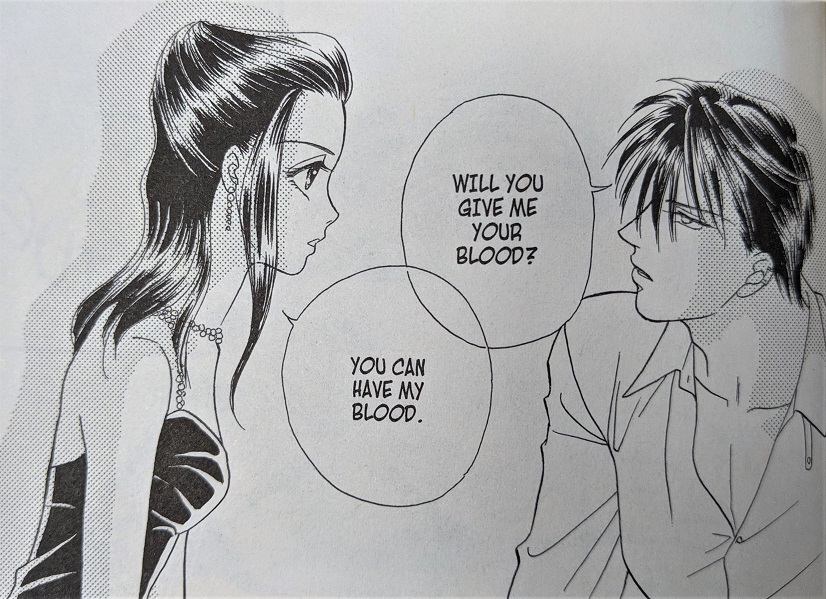
Midnight Secretary, by Tomu Ohmi — published by VIZ Media
This is, perhaps, the “trashiest” manga I like, the most indulgent of romances I can stomach. Our plucky protagonist, Kaya, is a damn good secretary, and she knows it. When she’s assigned to work with her company’s notoriously difficult director, she takes it in stride — until she discovers that he’s a vampire, and that he as a particular taste for her blood. Despite having all the trappings of a Harlequin romance novel, there’s something about Kaya’s stalwart dedication to her job, even in the face of an absurdly steamy vampire romance, that really endears me to it. And this a surprising series in that everyone I know who has read it loves it — regardless of their gender or their other manga preferences. It’s just charming fun, something a little lighter for those of us who want to get into the Halloween spirit but maybe don’t want to indulge in a gorefest.
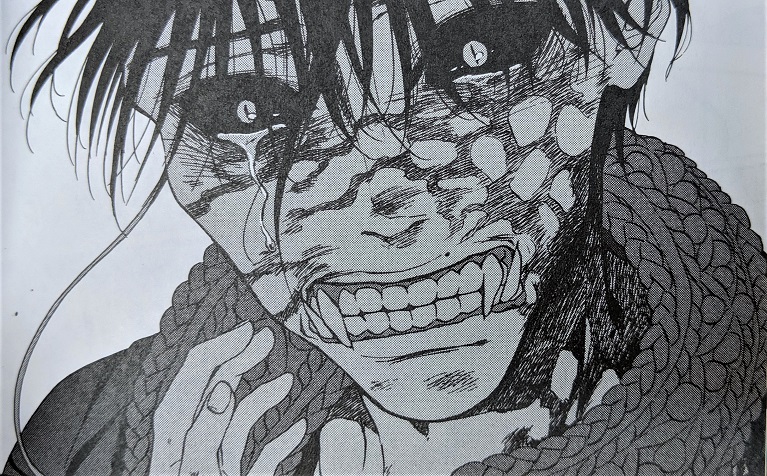
Devils’ Line, by Ryo Hanada — published by Vertical Comics
A decidedly different kind of vampire romance, I like Devils’ Line partially for Ryo Hanada’s penchant for drawing characters with dark under-eye circles — another weakness of mine! But in all seriousness, this story takes place in an alternate modern era where vampire-like people called “devils” co-exist in society but must live under strict rules or else be terminated by special police forces. Anzai is one such devil who works for the police, and in the course of his duties accidentally meets and becomes involved with a young, non-devil, woman named Tsukasa. The two cannot help falling in love with each other, but their romance is fraught with Anzai’s fears about his carnal nature taking over and turning him into a monster who harms Tsukasa. Add in a bunch of government conspiracy, and this is a fun thriller with plenty of blood, action, and a good sprinkling of sex. An anime came out last year, but I didn’t think much of the pilot; I would recommend going for the manga instead.
And with that, I’m calling it quits for now. As I said above, there are countless excellent horror manga — not to mention other horror comics! — but this list has got to end somewhere. You’ll notice that I didn’t bring up body horror (even though I do really like it) or Junji Ito at all. This was partially to keep this already long post a little shorter, and partially because I think, at least in the case of Ito, not much more needs to be said. Most horror fans know about Uzumaki, and with VIZ doing an excellent job of promoting all of his upcoming work, it’s hard to avoid hearing about Ito. It’s worth noting that he actually is one of my very favorite mangaka, so don’t take this as a slight against him, please! I’m just interested in promoting some lesser-known works this time around. I’m sure there will be opportunity to discuss more horror in the future.
I would like to wish you all a very happy, haunted, horrific Halloween! Have fun, indulge in sweets and spooky media and pumpkin spice! And don’t forget — Halloween can be every day if you so choose. ;3
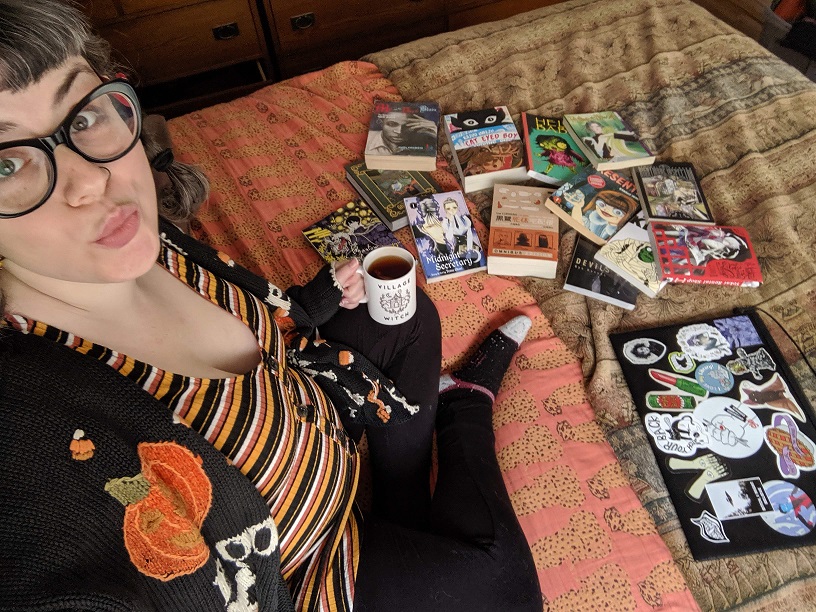
September Favorites
I’m a little later than usual this month! September was a good month, full of lots and lots of writing work, visiting in-laws, and a trip to New Hampshire for some good New England-y early autumn fun. I continue to grow rounder with each passing day, and the baby has decided to set up a dance studio in my belly.
In manga-related news, I got to cover Skull-Face Bookseller Honda-san and The Way of the Househusband for Comics Beat this month. I did mini-reviews of them here last month, but you can read a more detailed review if you follow the links. I’ve also officially started as one of the hosts of Manga Machinations, and it’s been so much fun. It’s really rewarding to be able to have good, engaging conversations with people about manga. And knowing that others are interested in listening to those conversations and providing their perspective is awesome, too. Aaaaaaand Selling Comics came out! My name and my writing is in a real, printed book! It’s so cool, I’m still kind of in shock.
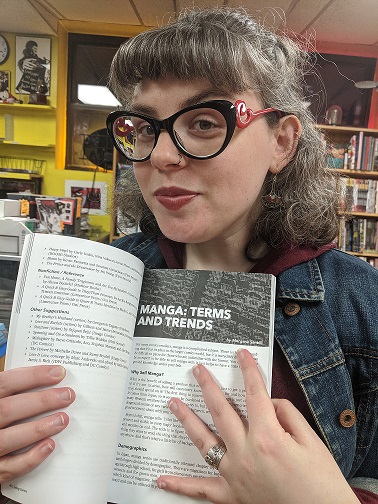
In terms of reading this month…unfortunately, a lot of it was for work or the podcast (and right now I’m reading a long-anticipated novel), so I only have one pick for you all. But it’s a real good one!

Phantom Tales of the Night, Volume 1, by Matsuri — published by Yen Press
Some of you may remember my love letter to Matsuri Akino’s Pet Shop of Horrors, one of my favorite manga of all time. My exposure to that series set in motion an obsession of mine; namely, the episodic morality play that utilizes an unreliable or amoral shop owner or service provider involved in the supernatural to mete out cosmic justice — or just sate his own desires — all wrapped up in a pretty, artistic package. Phantom Tales of the Night falls neatly into that description, with a mysterious innkeeper who trades protection, information, or a room for his clients’ secrets. And like every good nameless creepy innkeeper, his origins and history appear to be less than savory, though the first volume only gives us a glimpse at his arcane abilities. I’m such a sucker for stuff like this. It’s kind of pulpy, kind of queerbait-y, definitely pure, shameless entertainment. And while nothing will ever quite move me like the artwork in Pet Shop of Horrors, this series’s creator Matsuri (a different Matsuri!) has a lovely style that lends itself equally to beauty and body horror and weirdness. Again, totally my kind of manga.
And so, I end September and begin October on a decidedly spooky note. Historically, October has been an extremely busy time for me, and this year is no exception. I have volunteered to help with the Massachusetts Independent Comics Expo (MICE) this year, which is one of my absolute favorite local shows. If you’re around Boston the weekend of October 19-20, you should totally check it out and say hi! In between that, celebrating the season, and getting my normal work done, I’m going to try my best to read more. I’m hopefully going to also talk a bit about my horror manga recommendations! It’s something I always want to do but never quite get around to, and I’d really like to make the time to write about one of my favorite genres of manga.
Until then, happy reading!
TCAF Recap!
This past week has been an absolute whirlwind. Last Wednesday, I got on a plane to Toronto to start my volunteering adventure with the Toronto Comics Art Festival. I always love seeing the behind the scenes stuff at events, love learning how each team organizes their time and resources differently. And absolutely everyone on the TCAF team is absolutely lovely — so very kind and accepting and helpful.
I decided to volunteer for TCAF after leaving Comicopia, out of a desire to remain close to the comics community in a more tangible, physical way than just sitting at my desk at home and writing about manga. (I’ve also volunteered to help organize the Massachusetts Independent Comics Expo this year, for the same reason.) And for me, that’s really what comics is all about: a sense of community.
There were so many incredible events going on and comics work to see, but by and large the best thing about this show was the people I met and interacted with. Some of those were people I had met before and got to know better, and some of those were people whom I have been following and admiring for years and whom I was lucky to finally meet in person. And through it all, everyone was so kind and so supportive. I received so many words of encouragement and definitive, actionable advice from people with more experience and a better understanding of what the industry needs from an authoritative voice in manga.

And honestly — I just had a lot of fun. I got to work all the Junji Ito events, which was a really exhausting experience in many ways because everyone was SO EAGER to meet and listen to him. But that also means that I got to listen to him, even got to chat with him briefly. Hearing stories about his journey as an artist and what motivates and inspires him has rekindled an interest in writing about him — so look out for that soon, hopefully! He’s one of my absolute favorite mangaka of all time, and up until now I felt that he didn’t necessarily need my help getting any kind of recognition (whereas I strive to write about women a lot because I want to boost their readership). But sometimes…I just have to write things that are meaningful to me, and I would get a lot of satisfaction out of exploring the reasons I find his work so evocative and resonant in my life.
Because I was working events, I didn’t get a ton of time to peruse the show floor, but all the work I saw was truly incredible. Artists from all over were arranged on three full floors in the Toronto Reference Library selling their comics, bonding with readers, working on commissions. Attendance was enormous, and I heard from a lot of artists that they were amazed at how much they sold. This support for the arts, and for independent artists, is so admirable. It was so gratifying to be in such a positive, upbeat space. Even though I was working hard and not sleeping as much or as well as normal, the general good mood was palpable and infectious.
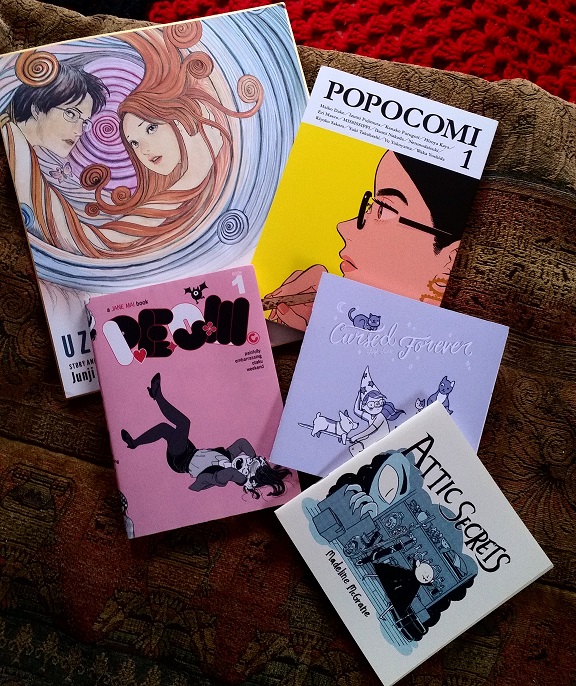
I was relieved to come home to my own bed, but also very satisfied in my decision to go to TCAF for the first time as a volunteer. It was a truly remarkable experience, and I hope that I can go back again next year — as a volunteer or otherwise — and experience the jubilant atmosphere and incredible conversations once again. I know that I’ve started relationships this past week that will last for many, many years to come. I’ve come away from this festival feeling rejuvenated, motivated, inspired, and so very, very grateful.
April Favorites
Every month, I get the itch to write this segment about halfway through, thus defeating the point of having a monthly round-up! I get too excited to talk about what I’ve just read, and I read a lot of good stuff in April.
Actually, a lot of stuff in general happened in April. I turned 29 on the 4th, so here’s to the last year of my 20s! My husband and I are in the midst of apartment hunting, which is always chaotic, especially here in the Boston area. And Anime Boston was last weekend! Even though I don’t technically work at Comicopia anymore, I helped with the ordering and was there on the floor from set up on Thursday to break down on Sunday. It was a really great show, and I’m glad I was able to be a part of it. Selling at conventions is my favorite kind of retail, because everyone is just so excited to be there and see what you’ve got and talk to you about it. And all the con-goers are so creative — I saw so many excellent costumes! Oh, and my very first post for Anime Feminist went up this week, as well: a spotlight on amazing artist and mangaka Junko Mizuno.
As May approaches, I’m getting ready to head over to the Toronto Comic Arts Festival (TCAF) for the first time, and I’m super excited. Between that and moving, May is going to be intense — but we’re not there yet. For now, I want to reflect on all the good stuff I read in April! And it’s actually all relatively new stuff this month, a sure change for me.
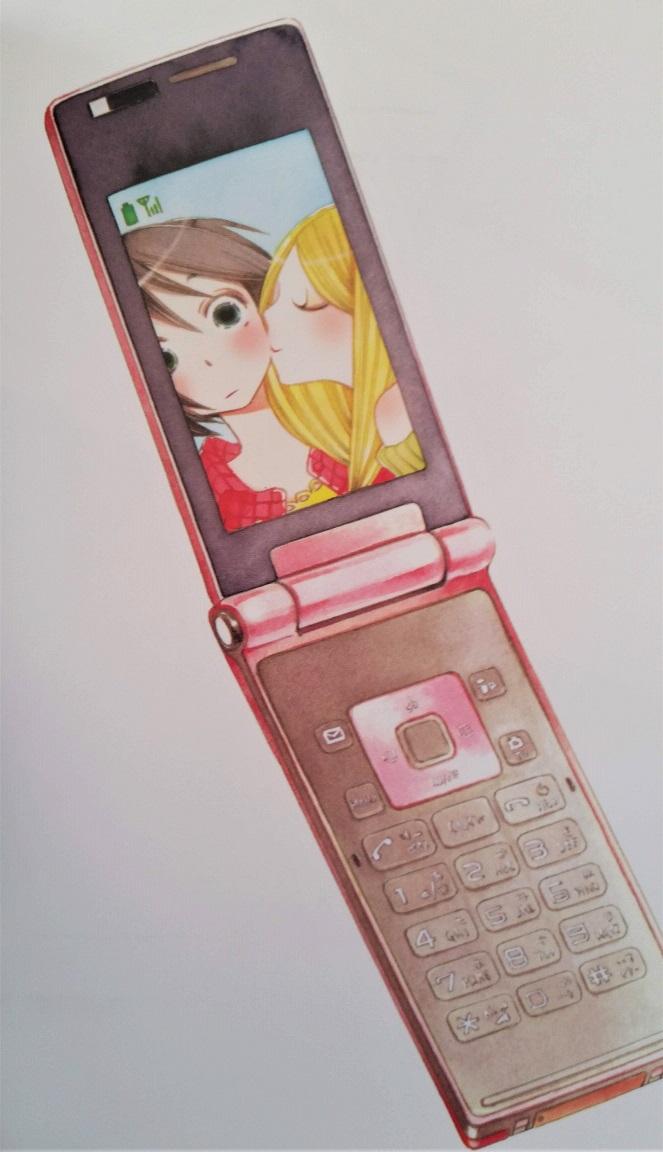
Maiden Railways, by Asumiko Nakamura — published by Denpa
This is the first of Denpa’s offerings that I’ve gotten a chance to read, and it’s the one I was most looking forward to. I love Asumiko Nakamura. Her art is so strange, both adorable and almost uncomfortable with all its sharp angles and long limbs. This volume is an anthology of railway-themed romances. It is simple and straightforward in many ways, but as with all of Nakamura’s work, it sets a very distinct tone, in this case of hope and longing and compassion. It’s a really lovely little collection with some lesbian themes neatly tucked into it with no fuss. Between this and Seven Seas’s upcoming print version of Classmates coming out soon, I am thrilled that more readers have access to Nakamura’s work.

Bloom, by Kevin Panetta and Savanna Ganucheau — published by FirstSecond
I had to wait for this book from the library for months, and I absolutely understand why — it’s absurdly charming. Ari’s dream is to move to the city with his band, but he can’t seem to escape his responsibilities at his family’s bakery. Hector, a culinary school student, has come to town to pack up his deceased grandmother’s home. Ari hires Hector to help in the bakery, in the hopes that by replacing himself, he will leave his parents no room to argue about his leaving home. But over the course of the summer, Ari and Hector grow close, and they have to make some big decisions about where their lives are headed, and whether those lives include each other. This book was so unbearably sweet, and so beautifully illustrated. Savanna Ganucheau does an excellent job of showing everyday examples of sexiness — nothing exploitative, but the little kinds of things that a person appreciates in their partner, like how they look when they’re focused, or how they move when they’re excited. With a cast diverse in both ethnic background and body type, and a strong, happy queer narrative, this is an incredibly delightful read for teens and up.
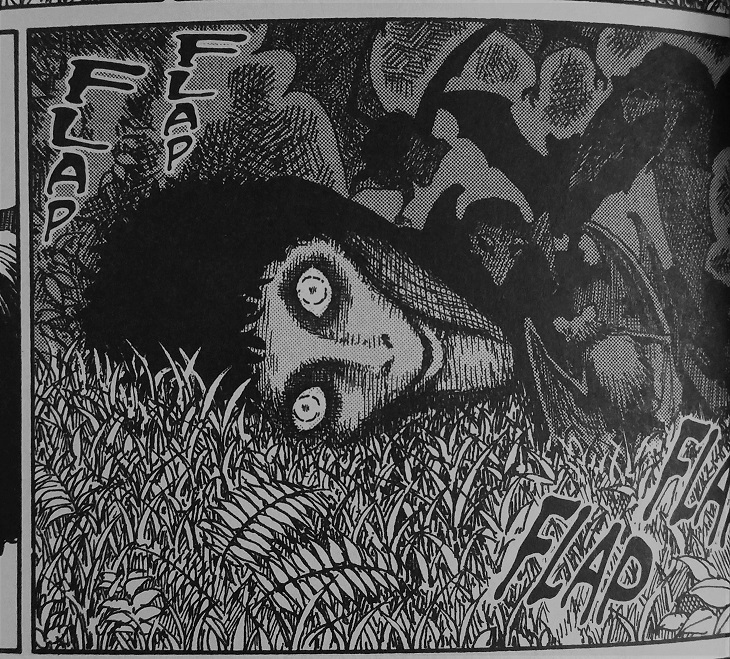
Smashed, by Junji Ito — published by VIZ Media
It’s no secret that I’m a HUGE Junji Ito fan. (That’s part of the reason I’m so excited about TCAF!) I never know what to expect with each new anthology: Will I be scared? Will I laugh? Will I feel like I just watched a particularly poignant episode of The Twilight Zone? For me, this collection had a lot of humor in it, and that is perhaps one of my favorite things about Ito’s work. There is a very fine line between comedy and horror, and no one loves to hop back and forth across that line as much as Ito. I think my favorites in this collection were “Bloodsucking Darkness” (because I love bats), “Soichi’s Beloved Pet” (because I love cats), and “Library Vision” (because I love books). The linked Soichi stories never fail to be silly fun, and as usual Ito’s artwork throughout the whole anthology is gorgeous and detailed. Truly, he is a master of horror, and all other kinds of base human emotions.

Kitaro’s Yokai Battles, by Shigeru Mizuki — published by Drawn & Quarterly
It’s been so long since there was another installment of Kitaro, and I was thrilled when I was alerted to this making its way into my pull at Comicopia. Who on this earth doesn’t love adorable, weird, childish monsters with potty humor? Only boring people, that’s who! In this collection, I was particularly fond of the “Oboro Guruma” chapter, in which Shigeru Mizuki has inserted himself as a major character, plagued by yokai who are taking over his home as their base of operations. As usual, Mizuki’s cartoony characters sit atop his lush and gorgeous backgrounds seamlessly, and the oft-times odd solutions to yokai-related problems harken back to simpler times and simpler story-telling mechanics. With each volume comes another installment of translator Zack Davisson’s “History of Kitaro,” which really appeals to my interest in both general world history and manga history specifically. A fun read suitable for just about anyone who appreciates a little dark whimsy in their life.
That’s going to do it for this month! I made the conscious decision not to include the sixth volume of Tokyo Tarareba Girls this time around, even though it’s one of my absolute favorite series, because I’ve already written about it in the past, and I anticipate I will talk at great length about it in many forms in the future. I thought I’d spare you all, haha.
I already have a huge pile of comics waiting to be read (don’t I always?), so hopefully I’ll have a nice round-up for May, as well. Happy reading!
The Beautiful & the Damned; Where Violence Meets Aesthetics in Pet Shop of Horrors
Among the extensive list of things I shamelessly love are: the occult detective genre, beautiful men, the monster-of-the-week format, and morality plays. Matsuri Akino’s Pet Shop of Horrors very neatly contains all of these things, and indeed might be the reason I’m so fond of some of them.
For those unfamiliar with this late-90s shojo series, the premise is that in LA’s Chinatown there is a mysterious pet shop whose proprietor, Count D, sells exotic “animals” to anyone who can pay the price. Each animal comes with a specific set of rules, and when those rules aren’t followed to the letter, tragedy inevitably occurs. LAPD officer Leon Orcot is assigned to investigate D and the weird phenomena linked to his shop, but in the process he is drawn into a series of Twilight Zone-esque situations that he cannot explain, let alone report to his superiors.
Right now, I can look at this premise and think to myself, “Yep, this is totally my kind of bullshit.” But when I first picked it up as a young teen, it was because I was drawn to its beautiful cover, where the androgynous D is holding a mermaid, whose back is turned to the viewer. D’s eyes are piercing and almost sad, his fingers long and delicate. I was in love with this man who moved in multiple worlds: the masculine and the feminine, reality and fantasy, beauty and horror.
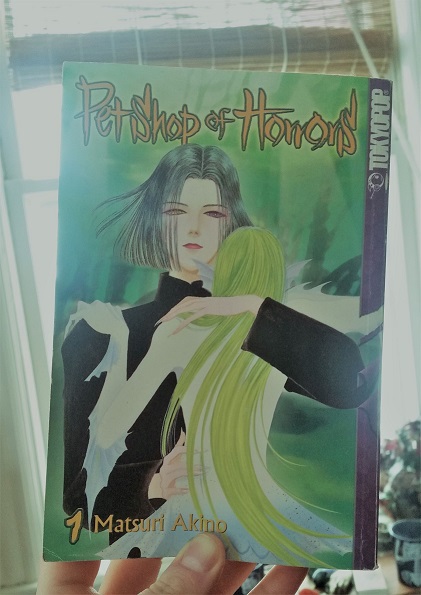
And when I bought and read this first volume, I was shocked. It wasn’t outright scary, necessarily, but it certainly was gory. In the first chapter already was there a horrific scene of evisceration, in and amongst all the trappings of a classic 90s shojo style, preoccupied with luxury and beauty. It was jarring, and it was effective. I discovered then that I didn’t dislike horror like I had previously thought, I just wanted it to be beautiful.
To this day, I find myself critical of scary or violent media that doesn’t also have a keen sense of aesthetics. I don’t necessarily enjoy being frightened; I am a naturally anxious person with vivid and violent dreams who does not react well to heightened suspense in media. I do like dark themes, though, and in recent years I have made it a point to expose myself to films especially that I know I would like if I could just get over my own hang-ups. And by being discerning, I’ve been rewarded with some of the most gorgeous horror and gore I’ve ever seen.
I think beauty and romance are natural companions to horror. All these themes pivot on an axis of drama, of amplified emotions. They all invoke visceral reactions, not logical ones. All my life I’ve surrounded myself with artwork depicting scenes and themes of witchcraft, hauntings, murders, martyrs, and mortality. It seems natural to me that scary things can pull at the same emotions I feel when I recognize something as beautiful.
And all this because way back in 2003, Tokyopop decided to take a chance on something that wasn’t very common in the comics world at the time: horror for girls. There’s plenty of it to be found in the manga world, and now there is more acknowledgement of girls and women reading outside of the romance genre. But it was new for me then, and even now Pet Shop of Horrors remains one of my favorite series, because it presented to me something I hadn’t known I was seeking out. It understood my tastes uniquely; it was able to marry my desire with my rage and prove them to be not disparate but intertwined and equally valid.
In truth, it is a somewhat silly series. It is certainly more fun than profound, but that in and of itself is not a criticism. It is pure, indulgent entertainment, and for me it is certainly laced with a nostalgic love that I will never be able to shake. How many times have I reread and referenced that first volume, gazing awestruck at the lovingly rendered intestines spilling out of a beautiful man’s body? How many times have I giggled at the flirtatious relationship between D and Orcot? How many times have I wished that modern depictions of mermaids were even half as scary as the one Akino has created?

The series is unfortunately long out of print, and later volumes are hard to find. I imagine that it wasn’t a huge seller for Tokyopop, though I am forever grateful that they took a chance on it to begin with. The anime is available to stream on HiDive, brief as it is, if you’d like to get a glimpse into Count D’s enigmatic Chinatown pet shop.
February Favorites
Time for something new! I’m going to start trying to round up some of my favorite comic reads at the end of each month. These won’t necessarily be things that came out the month in question (though I do try to keep up when I can), but anything I’ve managed to get my hands on that I feel is worth a mention. I read a lot, so I’m going to have to figure out how to limit my choices, but hopefully with time will come clarity!
I will say, first off, that this has been an…interesting month. I still feel so new to the freelance writing world, but I do think that things are coming together nicely, and I’m getting to a point where I can start challenging myself with how much work I take on. I also lost my cat, Mia, on February 12th. She was quite old, and her decline was very rapid. While she was sick, I spent a good deal of my time attending to her; after her death, there was a lot of time where I was just too miserable to feel like I wanted to do much of anything, let alone read. Still, a visit to Comicopia did help lift my spirits considerably, and while I have to be a little bit more judicious in my purchases right now, I was able to bring home some good new material.
I am also about to spend five days with my family while James is away on business, which is why I’m getting this out before the true end of the month. I suspect I will be too busy doing things with my mom and trying to keep up with my writing work to read too many more comics. But I wanted to give this segment a try, anyway, so I’ve decided to work with what I’ve got.
So without further ado, my picks for the month!
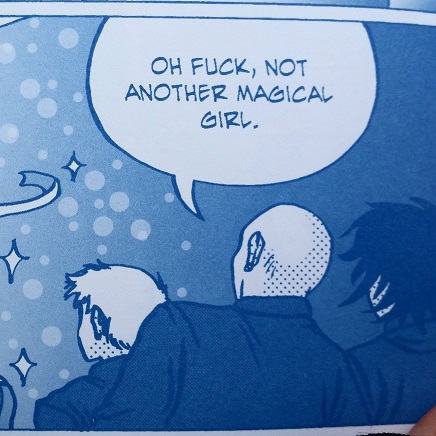
Magical Beatdown, Volume 1, by Jenn Woodall — published by Silver Sprocket
This slim little issue does one of my favorite things: It combines a love of the ultra-femme concept of the magical girl and mixes it generously with a hyper-violence that is both gross and cathartic at the same time. I think there’s a lot to be said about women enjoying and creating violent content, and some day I hope to talk about it more in-depth. But for now, I want to recommend the excellent pastel gore-fest revenge fantasy that is Magical Beatdown, because sometimes you just wanna go to the arcade without having to deal with losers! I’m looking forward to getting my hands on the second installment.

House of Penance, by Peter J. Tomasi, Ian Bertram, and Dave Stewart — published by Dark Horse Comics
Speaking of gore-fests, this standalone graphic novel is not for the faint of heart or stomach. The Winchester mansion in San Jose, California, is famous for it’s staircases that lead to nowhere, its doors that open onto nothing but air, and the nagging suspicion that it is not entirely empty. House of Penance is an exploration of Sarah Winchester’s mental state as she commissions the building of this strange domicile while grappling with the grief of losing her daughter and her husband, and the guilt of inheriting the wealth from a company whose business is murder. I’m always down for a strong anti-gun message, personally, and there is no holding back here as Sarah is confronted relentlessly by the victims of her in-laws’ firearm empire. Ian Bertram’s art is eerie and textured, Sarah especially portrayed with bug-like eyes that can see more than the men working around her. Dave Stewart’s incredible colors compliment Bertram’s lines beautifully, and his use of bright, vibrant blood red is very effective.
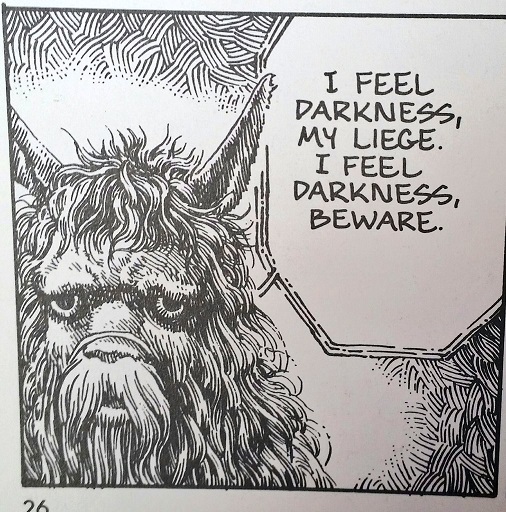
Shion: Blade of the Minstrel, by Yu Kinutani — published by VIZ Media (out of print)
I came upon this volume completely by accident, while I was still working at Comicopia. It was hidden away in storage, in a long box full of old single issue comics, many of which were single issue manga, from way back when everything was flipped and companies tried selling manga like Western single-issue comics. I was drawn to its striking cover and detailed artwork, so I brought it home. That had to have been nearly two years ago, as I had put it into a comic box and promptly forgotten it. I dug it out recently while I was doing some organizing, and I resolved to finally read it.
And honestly, I was stunned. This little volume is so extraordinarily different from any manga that is being licensed and published today. It wouldn’t be seen as marketable, probably, but I’m so glad that VIZ took a chance on it back in 1991, because it was a pleasure to read. The book is split into two stories that follow a mysterious minstrel who must first take his revenge on a monster who wronged him and his family, and then must take up a legendary sword to fulfill his destiny. That one sentence seems like straightforward fantasy, and in many ways that’s what Shion is; as an essay at the back of the volume explains, it is a classic hero arc seen in many fairy tales and epics. But it’s so gorgeously textured in its artwork, and for me it invoked the same feelings as Vampire Hunter D and classic Jim Henson works, especially The Dark Crystal. It’s creative and beautiful, and I’d love to see what Kinutani did after this work. Worth hunting down if you are able!

My Solo Exchange Diary, Volume 2, by Nagata Kabi — published by Seven Seas Entertainment
In many ways, there’s not much I can say that I haven’t said before, in various spaces, about Nagata Kabi’s autobiographical work. Of the three volumes she has out from Seven Seas right now, I think this one was my favorite, even though much of it was spent talking about her time in the hospital. I appreciate, more than ever, her honesty, especially as she realizes how her mental state had prevented her from understanding how much her family actually loves her and wants what’s best for her. She continues to struggle throughout the volume, but it is evident that she’s repairing her relationships and learning, slowly, how to better communicate her pain so that she’s not suffering alone. I know that many people have been critical of her constant self-destruction, but to that end I just have to say…it is evident those people have never struggled with serious mental illness, or really known anyone who has. What Kabi is going through is not logical, it is not easily navigated, and her honesty and willingness to expose herself like she this has surely had a positive effect on others who have felt similarly isolated, self-destructive, and hurt. I continue to send her only the kindest, gentlest, most positive thoughts as she works on overcoming her pain. It’s a hard road, and she’s been working at it for a long, long time. I hope she’s able to find some peace soon.
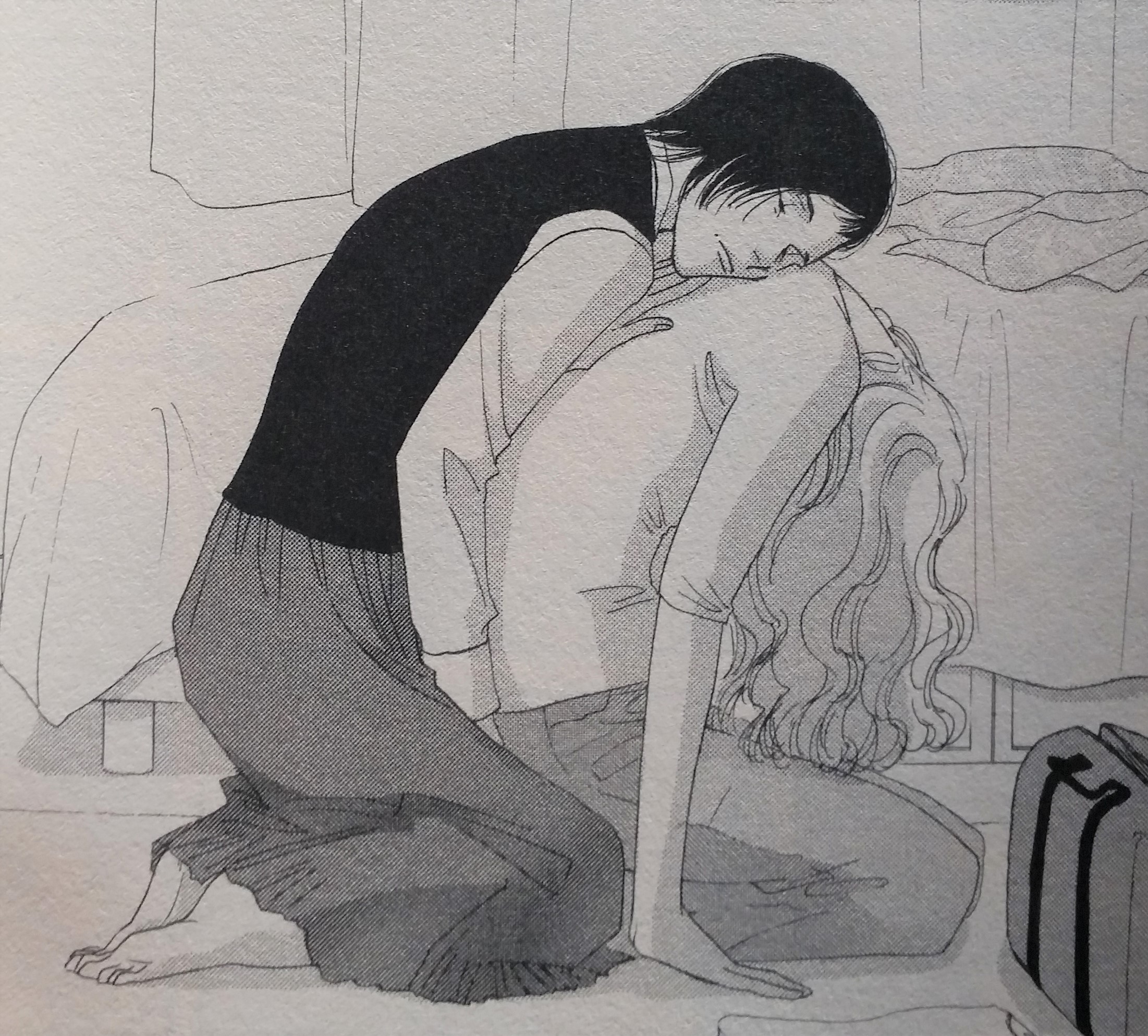
All My Darling Daughters, by Fumi Yoshinaga — published by VIZ Media
Fumi Yoshinaga is one of those creators whose work I always know I’ll enjoy, but who also manages to completely exceed my expectations every single time. So was the case with All My Darling Daughters, a standalone volume that explores various relationships between people in a friend group, with special emphasis on the one between Yukiko and her mother, Mari, who has married a much younger man. Yoshinaga has such a sensitive touch with her characters that I find myself sympathizing even with those who in a different author’s hands, I would absolutely hate. It is an incredible skill to express the nuances of humanity, and Yoshinaga is extraordinarily good at it. I felt especially drawn to the last story in the collection, which dives into Mari’s antagonistic relationship with her own mother (Yukiko’s grandmother). Mari hates her mother for having been unnecessarily cruel about her appearance while she was growing up, not realizing that her mother was trying, in her own imperfect way, to protect her daughter from becoming reliant on her good looks. I was so strongly reminded of the dynamics between the women in my own family, the dynamics between my mother and my grandmother, and the increased awareness I have lately of how heavy motherhood can be. “A mother is an imperfect woman,” Yukiko realizes, and it is a perfect underscore to a book full of imperfect people who are just trying to do the right thing.
Looking back, it seems I’ve read a lot of very different books this month, but there are certain themes that run throughout. A lot of introspection, explorations of mental health (both real and fictional), and a little bit of violence and some adventure to balance things out. I like the micro-review format because I can fit several recommendations into a post at once, and I am not liable to give too much away. I hope this proves useful, and I look forward to following up again next month with some more excellent reads!